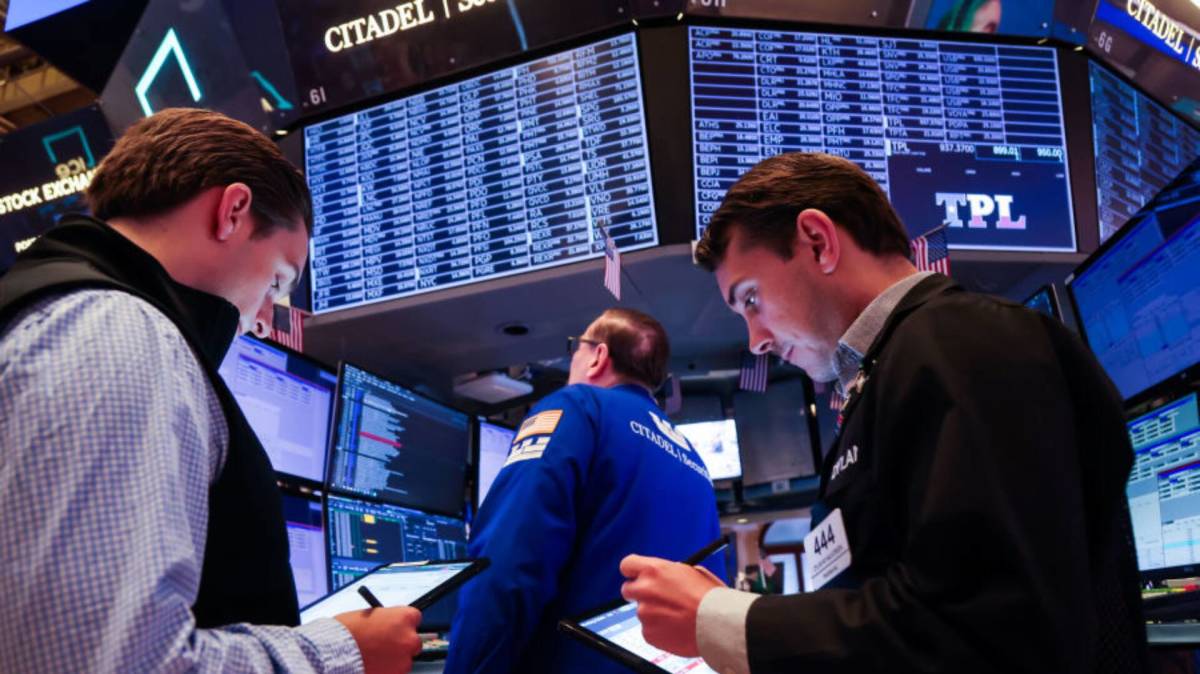Artificial intelligence is changing what you see. Don’t miss breaking market news and investing insights written by humans – click here, then check TheStreet box to see us first.
In April, you’d have to look pretty far and wide to find a bullish investor. Reports of looming stagflation—slow growth and rising inflation—and outright recession were everywhere in the wake of President Trump’s harsher-than-hoped tariff announcements.
It turns out that was the perfect time to buy stocks. True to form, the stock market found its footing even as sentiment soured in early April, and ever since, it’s been climbing the proverbial ‘wall of worry’ on hopes trade deals and tax cuts would trump tariff pains.
On Aug. 28th, we received economic news that shed light on the economy and supported investors’ bullishness this summer.

Bloomberg/Getty Images
The stock market’s record-setting run
Stocks have delivered eye-popping returns since April 8:
- S&P 500: 30%
- Nasdaq Composite: 41%
- Nasdaq 100: 38%
- Dow Jones Industrial Average: 21%
- Russell 2000: 35%
The gains contrast sharply with the steep losses the market experienced beginning in February 2025, when the first tariffs on Mexico, Canada, and China were announced.
Stock market declines from February highs to April lows:
- S&P 500: -19%
- Nasdaq Composite: -24%
- Nasdaq 100: -23%
- Dow Jones Industrial Average: -16%
- Russell 2000: -24%
U.S. economy delivers goldilocks second-quarter performance
Worry that tariffs will drive inflation higher remains, but concerns have tamed as inflation has remained in check despite a spike in the effective tariff charged on imports.
Related: Bank of America rings inflation alarm ahead of PCE report this week
According to Yale Budget Lab, the effective tariff rate on global imports has swelled to 18.6% from 2.4% in January.
Despite that surge, the Bureau of Economic Analysis’s second-estimate for the second-quarter GDP showed that Personal Consumption Expenditure (PCE) inflation was a tepid 2% last quarter, down from 3.7% in the first quarter.
“The hypothesis of a resilient US economy just got support from the revised estimate of Q2 GDP for the US. This was increased from 3% to 3.3%, surpassing the consensus forecast of 3.1%,” wrote long-time economist Mohamed A. El-Erian on X, formerly Twitter.
Core PCE inflation, which strips out volatile food and energy, was 2.5%, down from 3.5% in Q1.
Overall, second-quarter GDP rose 3.3% in Q2, reversing a 0.5% contraction in GDP during the first quarter.
The boost in GDP was due to lower imports. If you recall, first quarter’s contraction was fueled partly by a surge in imports to get in front of tariffs. It was also due to “an increase in consumer spending.”
More Economic Analysis:
- What the star-studded Jackson Hole Fed meeting means to you
- Producer price inflation shocks Fed interest rate cut bets
- White House taps more potential candidates to head the Fed
The U.S. Census Bureau previously said total retail sales rose 3.9% in Q2 from one year ago, led by e-commerce sales, which increased by 5.3%. Overall, retail sales totaled a whopping $1.9 trillion last quarter.
According to FactSet, S&P 500 companies reported second-quarter earnings growth of 11.8%, the third consecutive quarter of double-digit growth.
Little wonder stocks have rallied strongly.
Economy isn’t out of the woods yet
It’s tempting to extrapolate the second quarter strength, but there are concerning signals that last quarter’s Goldilocks quarter may have been a one-off.
- Rising unemployment
- Surging layoffs
- Upticking inflation
The unemployment rate is still historically low, but at 4.2% last month, it was at the high end of its range over the past year and up considerably from a low of 3.4% in 2023.
Related: Consumer confidence sends worrisome signal on economy, inflation
Not helping matters is a surge in layoffs this year, particularly in technology, and because of the DOGE cuts earlier this year, within the government.
In July, layoffs were up 140% year-over-year, continuing a concerning year-to-date trend.
Challenger, Gray & Christmas reports:
“Companies have announced 806,383 job cuts, the highest YTD since 2020 when 1,847,696 were announced. It is up 75% from the 460,530 job cuts announced through the first seven months of last year and is up 6% from the 2024 full year total of 761,358.”
Year-to-date, technology has seen the most job cuts, with job losses up 36% this year.
The recent weakness in the jobs market is even more concerning given that, despite tame inflation in Q2, we could be seeing tariffs flow into prices more in the third quarter.
Consumer Price Index inflation in July was a still-manageable 2.7%, below the 3% rate in January, but up from 2.3% in April before most tariffs kicked in.
We’ll get the July PCE inflation report on Friday, Aug. 28.
Related: Fed official sends dire warning on US economy
#039Goldilocks039 #economy #throws #light #surging #stocks